Gee Bee R1, 1/48 Dora Wings
This time I am presenting you quite a quick project, given that I managed to complete it in less than two months. I started the Dora Wings model for the first time and I have to say that I am satisfied with the quality of the product, although more corrections were needed than I would have expected at first. The packaging itself already contains some photo-etched parts, masks for clear parts (which I didn't use myself) and for the paint scheme, and above all I have to praise the excellent decals.
As I mentioned before, quite a few corrections were needed, as the stringers on the fuselage were too bold, also I wouldn't exactly praise the joint between the fuselage and the wings. In my opinion, the biggest problem is the canopy, as in the first phase it is made of two parts, and the second bigger problem is that the shape of the frame is wrong, so I decided to make a new one myself.
As far as painting is concerned, masks come in very handy, as masking alone would be very time consuming. The decals are, as I mentioned earlier, fantastic, very thin and after application the carrier film is practically invisible.
For some extra spice, I added a figure from Verlinden Productions - US Navy Pilots, which I had to rework a bit.
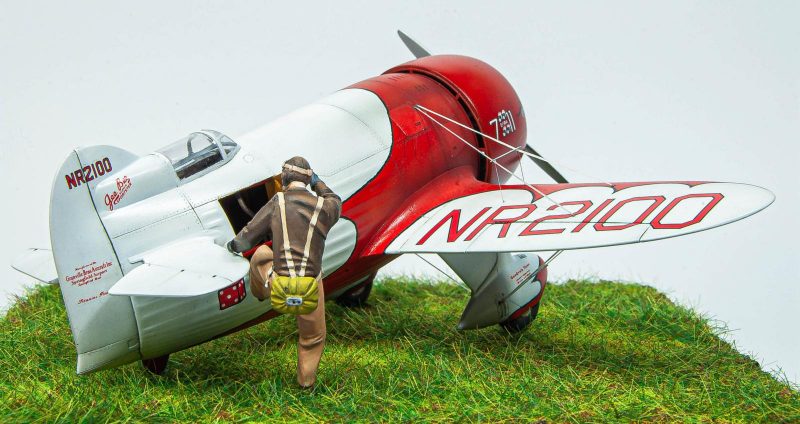
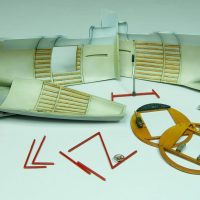
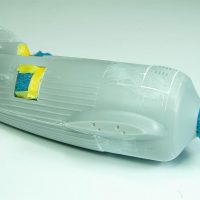
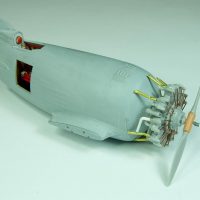
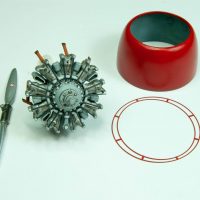
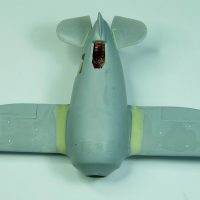
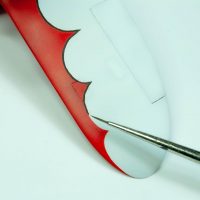
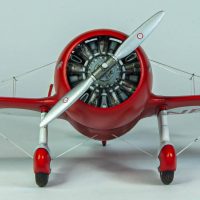
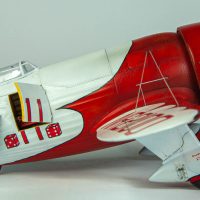
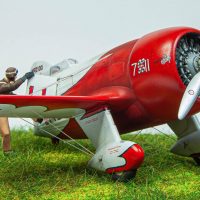

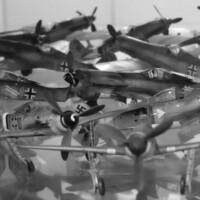
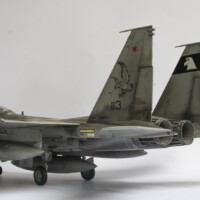
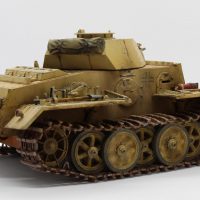
Amazing work!
I remember reading a description of flying the Gee Bee as being like balancing a pencil on the tip of you finger.
Doolittle's observation was that it was like trying to balance a ruler on the pointed end of a pencil.
Interestingly, it all seems to have been the choice of airfoil, a "Clark Y" that wasn't right for the performace - the modern replica changed to a modern airfoil and all was well with it - the guy used to do aerobatics at airshows with it.
I saw those aerobatics, always made me nervous, but it was so cool!
According to the builder, Steve Wolf, they did not change anything aerodynamically. They built it as close as possible to the original. The ONLY changes were hydraulic brakes, a tail wheel replacing the skid and modern radios. Now, two Gee Bee Z replicas that have been built. One belonging to Kermit Weeks which is as faithful a replica as Delmar's (now Kermit's) R2. However, the one built by Jeff Eicher (and used in the Rocketeer) IS altered from the original being both greater in length and span.
Anže - It is just a beautiful build and the pilot figure adds a lot. It shows just how small a ship it really was. Very nice painting and "weathering" job as well. As to Tom's comments, NONE of the Granville-built Gee Bee monoplanes ever used the Clark Y airfoil. ALL the Granville built Gee Bee Sportsters used a pre-1927 NACA "modified M-6" airfoil and so did the 1992 Benjamin/Wolf R-2 replica. Zantford "Grannie" Granville wrote in the July, 1933 Aero Digest issue: "Seven of the M-type airfoils may be classified as the 'stable series' of that series. The center of pressure travels towards the trailing edge as the angle of attack is increased from low to high angle of attack. The M-6 section has the smallest total center of pressure travel, namely 9%. For the Supersportster wing, sufficient spar depth was possible with ordinates of M-6 reduced to 65%." 1/10th scale wooden models of the plane (and wouldn't we love to still have these today) were tested in the New York University wind tunnel during the design. "It was a widely known engineering fact that the ideal shape for a body moving through a fluid was teardrop with a ratio between length and diameter of 3 to 3.5 to one, so Granville and [chief engineer Pete] Miller did a study to determine how close they could come to the ideal teardrop that had an engine, wings, landing gear, cockpit and a tail attached to spoil the airflow around it." As it turned out, the thick fuselage was itself an airfoil, a "lifting body," conservatively adding another 36 sq. ft. of lifting area. You can see that in the videos of Delmar Benjamin and Steve Wolf's R-2 replica flying a perfect knife-edge in a level attitude. After winning the 1932 Thompson trophy race in the R-1 Doolittle told reporters "She's the sweetest ship I've ever flown." On the advice of long time pylon racer, Lee Gehlbach, the controls were designed to be as light and sensitive as a fighter plane. He told the designers that in pylon racing, with a gaggle of planes at flying full speed in turbulent air, jockeying for position, wing to wing, all heading into the same pylon turn, were going to be quick or dead. The Benjamin/Wolf R-2 replica was sold in 2004 to Kermit Weeks "Fantasy of Flight Museum" in Polk City, Florida after Delmar, an excellent pilot, had flown it for over 1,500 accident free miles. It shows just how small a ship it was. Very nice painting and "weathering" job as well. As to Greg's comments, NONE of the Granville-built Gee Bee monoplanes ever used the Clark Y airfoil. ALL the Granville built Gee Bee Sportsters used an NACA "modified M-6" airfoil. Zantford "Grannie" Granville wrote in the July, 1933 Aero Digest issue: "Seven of the M-type airfoils may be classified as the 'stable series' of that series. The center of pressure travels towards the trailing edge as the angle of attack is increased from low to high angle of attack. The M-6 section has the smallest total center of pressure travel, namely 9%. For the Supersportster wing, sufficient spar depth was possible with ordinates of M-6 reduced to 65%." 1/10th scale wooden models of the plane (and wouldn't we love to still have these today) were tested in the New York University wind tunnel during the design. "It was a widely known engineering fact that the ideal shape for a body moving through a fluid was teardrop with a ratio between length and diameter of 3 to 3.5 to one, so Granville and [chief engineer Pete] Miller did a study to determine how close they could come to the ideal teardrop that had an engine, wings, landing gear, cockpit and a tail attached to spoil the airflow around it." As it turned out, the thick fuselage was itself an airfoil, a "lifting body," conservatively adding another 36 sq. ft. of lifting area. You can see that in the videos of Delmar Benjamin and Steve Wolf's R-2 replica flying a perfect knife-edge in a level attitude. After winning the 1932 Thompson trophy race in the R-1 Doolittle told reporters "She's the sweetest ship I've ever flown." On the advice of long time pylon racer, Lee Gehlbach, the controls were designed to be as light and sensitive as a fighter plane. He told the designers that in pylon racing, with a gaggle of planes at flying full speed in turbulent air, jockeying for position, wing to wing, all heading into the same pylon turn, were going to be quick or dead. The Benjamin/Wolf R-2 replica was sold in 2004 to Kermit Weeks "Fantasy of Flight Museum" in Polk City, Florida after Delmar, an excellent pilot, had flown it for over 1,500 accident free miles.
Thank you Steven!
Well done Anže. The Verlinden figure really makes it.
Thank you Eric!
Absolutely STUNNING. This is my all time favourite classic racing aircraft! Your model is awesome on every level!
Thanks Morne!
Very well made GeeBee Anže @anze93!
Thank you!
Fantastic result, Anže.
Nice to see how that pilot enters the plane from the side of the fuselage.
Thank you John!
Sharp. A real eye-catcher. The pilot really adds to it a lot.
Thanks Bill!
Well done Anze, she looks great. Jimmy Doolittle quoted that the Bee Gee "was the most dangerous plane I ever flew."
Thank you!
I really like this. Well done.
Thank you!
Beautiful rendition of a famous racer. And that gold line painted with a fine brush...nerves of stell. Yes sir, thumbs up!
Thanks Pedro! Well I didn't have the nerves to mask it...
Real nice! Great free hand brush work.
Thank you Robert!
Very nice job
Thanks!
This is some very fine modeling.
Thank you!
Sweet build. Really like the free hand pin stripes.
Thank you Haslam!
Yeah the brushed pinstripes are really impressive. I have the Testors (Hawk) kit of the Gee Bee and that's the best, or only practical way I can figure to do it too, now I just have to do it. You've proved it can be done, the challenge is set.
I also agree the figure really adds a lot. So many times figures look unnaturally posed but this guy really looks like he's getting into it. Fantastic work on every level.
Thank you John!
Excellent build. Really well done!
Thanks!
I always imagined the Gee Bee to be larger. But seeing a pilot next to it shows that it was really nothing else, but a flying engine with tiny wings on it.
Great build!
Thank you!
🙂 ... Greetings ... 🙂 :
I love dioramas and this one is no exception.
Very nice modeling Anže.
The paint and the gloss sheen to it looks great as well as the rigging.
This diorama clearly shows the importance of figures ( in this case a figure ) on a sit alone model or a diorama. It gives the viewer a chance to comprehend the size and design of a machine.
Very good work, thank you for sharing these pictures.
Thank you! I also think the figures are as important as the main model but I still need to get some experience in painting them.
This is an amazing GeeBee, Anže!
I love all thos details you added, especially engine and cockpit.
Congratulaions!
Thank you!
Cute and simple object of attraction 🙂
Thanks Martin!
Great looking plane and presentation of the model. The pilot figure and a bit of ground really add so much extra to the story.
This is my take on the GeeBee theme some years ago https://imodeler.com/2016/02/fiat-gb-500-bis/
Thank you Stellan!
The grass looks a little too long, but this is a fantastic model, definitely liked.
Thank you! Yeah well, I will need to buy some shorter grass.
Anze, @anze93
My friend you have built an amazing Gee Bee plane. I like everything I see here. Interestingly enough, this plane is my wife's favorite airplane. We have made several trips to Kermit Weeks' museum called Fantasy of Flight. He has several Golden Age air racing planes in his collection, and the Gee Bee was one of them. We had to get a picture of her standing next to it before we left.
I have built up a Gee Bee model in the past, but I don't remember the name of kit manufacturer. It's 1/32 scale and it could be a Lindberg kit. It was part of a series of similar planes, and the Laird Special was included in the group. I still have a 1/32 scale Williams Brothers kit left in the stash to be built.
Thanks for sharing this with us, and I definitely pressed the liked button. Now I will have to go look at the plans I have for an electric powered flying scale model of the Gee Bee. I think it is a 1/5 or 1/4 scale model.
You did a fine job with yours.
Thank you Louis, I hope I will get the chance to see real one someday.
Always one the coolest planes built. Nice job! LIKED!
Thank you Matt!
Very very nice work. Looks stunning. Gee Bee is a cool plane and your display does an excellent job of presenting it.
Thank you!
Cool build of one of the most dangerous planes ever built.
Thank you!
A keen modeler! Beautiful presentation! I really
love this!
Thank you Gabor!
A beautiful build! If I were a pilot (I have flown with my dad), I don't think I could have been convinced to strap that thing on to my behind! An oil drum with wings and a tail!